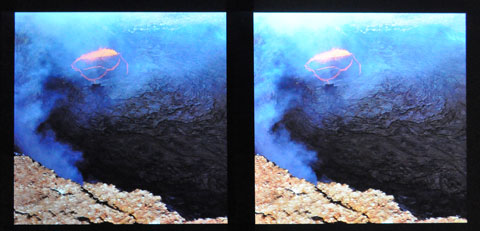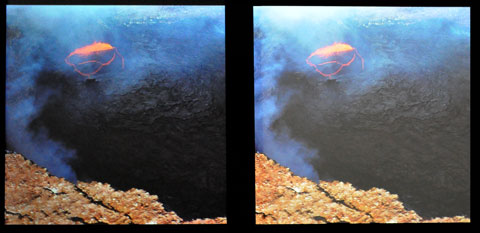Draper Onyx with XS850E Ambient Light Rejection Screen Review
Clicks:67502015-08-14 21:13:45 From: ProjectorCentral.com
While home theater and home video projectors get brighter every year, ambient light is still the main reason many people cite for why they cannot put a projector in their home. Ambient light washes out a projector's black levels, obscuring shadow detail and compressing dynamic range -- both of which are vital for good video.
The new Draper XS850E fabric is an ambient light rejection screen material for front projectors that helps to preserve a projector's image fidelity in ambient light. By only selectively reflecting the projector's light back towards the audience, the XS850E reduces the negative effects of ambient light on projector black levels. Light from sources above or to the sides of the screen are rejected (absorbed) rather than reflected, making ambient light rejection screens like the XS850E the best way to improve black levels in ambient light conditions. A 100" Onyx screen with Veltex coating and XS850E fabric has a suggested retail price of $2,717.
Draper sent us the XS850E in an Onyx frame, which is a fixed-frame aluminum screen for wall-mount use. The Onyx frame has a 4" wide black aluminum border around the image area that can be optionally enhanced with Draper's Veltex velvet material. Our test sample included the Veltex material, which absorbed any stray light falling outside of the screen's imaging area.
The Draper XS850E is built for ambient light, but we initially set it up in a darkened theater environment. This allowed us to compare it against our usual screen, a Stewart Studiotek 100. We have included images below which are illustrative of the type of differences you can expect, though they are imperfect reproductions that do not fully capture the contrast and detail present in the actual projected image.
In the dark, the XS850E's 0.85-gain surface reflects less light than the Studiotek 100's 1.0-gain, making it appear less bright than the white screen. The XS850E fabric also has a narrower viewing angle than the Studiotek 100, but this is both normal and expected; the ST100 is a lambertian reflector, so it has no half-gain angle and appears equally bright from all angles. Compared to the Studiotek 100, the XS850E has slightly deeper blacks in addition to the dimmer highlights and overall darker picture. Color is shifted towards blue slightly, and there is no significant difference in clarity of detail.
Turn the lights on, and everything changes. Suddenly, the Studiotek 100's black level shoots up due to ambient light. The deepest shadow detail is lost, as well. Color shifts towards yellow, the predominant color of indoor lighting. Meanwhile, the projected image on the XS850E fabric changes as well, but not nearly as much. Black levels rise slightly, though shadow detail is maintained much better than on the white screen. And in response to the largely yellow ambient light, white balance shifts away from blue and back towards a more neutral tone.
Without the lights on, there would be little reason to choose the XS850E over the Studiotek 100. With the lights on, there would be little reason to choose the ST100 over the XS850E. It all comes down to application.
| Review Contents: | The Viewing Experience | Key Features | Limitations and Conclusion |
Reader Comments(7 comments)
Posted Oct 20, 2013 6:42:12 PM |
|
By Rick |
Post a Comment Alert Moderator |
...even better, if we could compare to DNP and BD
Posted Sep 18, 2013 9:57:17 AM |
|
By James |
Post a Comment Alert Moderator |
Stewart materials are gray but they are not an engineered screen material in the same category of the Draper XS850E and the DNP Supernova. In a dark environment the Stewart screens are fantastic products that perform amazingly well. They are however for dark <3-4fc ambient levels. So they just aren't for all applications. Especially high ambient light.
When it comes to ambient light rejection, the Supernova 08-85 material is much better than the XS850 material. The Draper XS850 does reject ambient light but not nearly to the same efficiency as Supernova material. For moderate ambient light 6-20fc off axis to screen perpendicular use the XS850 and it will hold its own relatively okay. Beyond that use the DNP. I.E if you have a side window DNP it is. or You get what you pay for. If you need much higher rejection then it'll cost. If you want moderate rejection then you can save a bit and get the Draper. :-)
To speak to projector contrast. Bluntly. It next to irrelevant by the spec. I have measured with the proper tools projectors from almost every manufacturer, and unless you are talking high power 3chip DLP units from Barco, Christie, NEC, Projection Design etc, the specs sheets are mostly marketing garbage. Getting a final image in a room after setup that is above 250:1 properly is incredibly difficult. The room itself is the problem. How many people have a black room (including the ceiling) with black furniture, wear black clothes etc... Contrast is a system value NOT just a projection value.
To speak to projector brightness. ANY screen with less than 1.0 gain requires the projected light per sq ft to be higher. Can a 600 lumen do the job... maybe. How big is the screen? Lumen is total light by area, increase the area you need a bigger engine (projector). Also where in the lens throw is the projector? Most lenses are brightest near the front and sometimes by significant amounts! I have measures 40% light loss on lenses before, and a 25% sway is common. Yes COMMON. Buy a light meter or a colourimeter and check.
This is why screen like the DNP, and Draper are actually great things for home theatres. They enable a real world usable room to be a theatre room AND maintain a contrast level that would be unobtainable without them.
Even Stewarts material is great for rooms where ambient is from the system itself and from lower light sources. Dimmable lamps, or floor lighting. And yes it still requires more output power net. To speak to why show a white screen (which I think is brilliant), its because it shows why this type of screen is beneficial as a TYPE. Showing against the same type screen is product comparison like a granny vs a Royal Gala apple. This is an Orange vs and Apple article and product.
Robert, what are the direct and indirect ambient light measurements in your room at the screen location? You can use fc or nit. What is the size of your screen? What is the measured white output of the project with the lights off at at the screen center, and at 8 points around the edge? What is the black levels with the lights off at center? What is the black level with a half full white square on one side and visa versa?
For this case use all measures towards the projector with a diffusion filter on the projector to remove your current screen from the equation.
Also if you want to post bulb hours and projector model that would help.
Cheers James
Posted Sep 8, 2013 6:25:32 PM |
|
By Robert Hart |
Post a Comment Alert Moderator |
Black screens have the advantage of giving the appearance of great blacks when using brighter projectors. Bright professional projectors with 5000 - 20000 lumens typically have a contrast ratio of between 2000:1 and 8500:1. Compared to the 50,000:1 you expect from a ht projector, blacks could use a little help. I use a black screen to enable me to get great blacks from a brighter projector. It is enough to close the gap in most cases. Both my bright projector and my 50,000:1 contrast ht projector have great blacks but now my bright projector keeps them with the lights on. My ht projector is barely visible with the lights on. All that contrast is wasted and the best it can do is a washed out image.
The other point here is, why would you compare it to a white 1 gain screen? The review stated the obvious. We knew one would look better in light conditions before we started reading. We aren't stupid. We wanted to know how it compares to other screens that claim to work well with the lights on. Specifically, black diamond, steward g3, standard grey screens and maybe even the benefits over a DIY black widow screen.
$3000 for a pece of material might sond like good value to you but how much advantage does it give over a grey screen which can be bought or made for far less? How does it look with brighter projectors that have a chance of working with ambient light? Would I be better off putting $3000 onto this s Rene or buying a brighter projector?
I would also like more info on how it works and what it is made from. This "multi-layered" description tells me very little and that makes it harder to judge if $3000 is a good deal or if I'm buying a few different colors of PVC material pressed together. "Selectively reflecting" can mean 2 things. One definition is like the dichroic coating that Sony claimed on their Chromavue screens. The others like the micro-louvers the black diamond and DNP screens use to block light from the sides and above.
I would point out that when they were available, Sony sold its black screen Dynaclear for $400 for the 80 inch. I can honestly say that was good value given that there was no other material like it at even close to the same price range. At $3000, these screens sound like a rip off and tha the reason why how they are made is a secret is that we would see how little it was worth it.





Posted Oct 28, 2013 1:36:32 PM
By Robert Hart
I hope this helps. BTW, for the high end black-screens I have seen, I saw little evidence of selective ambient light blocking. If it is there, it doesn't make enough of a difference to notice. Most of the improvement in performance seemed to come from the darker screen surface so the projector didn't have to rely on darkness to simulate blacks. The BD in particular seemed to suffer from surface glare instead of rejecting other light sources. I would advise a live demo to avoid disappointment. Manage your expectations. They are an improvement but you JVC still won't work against direct sunlight.